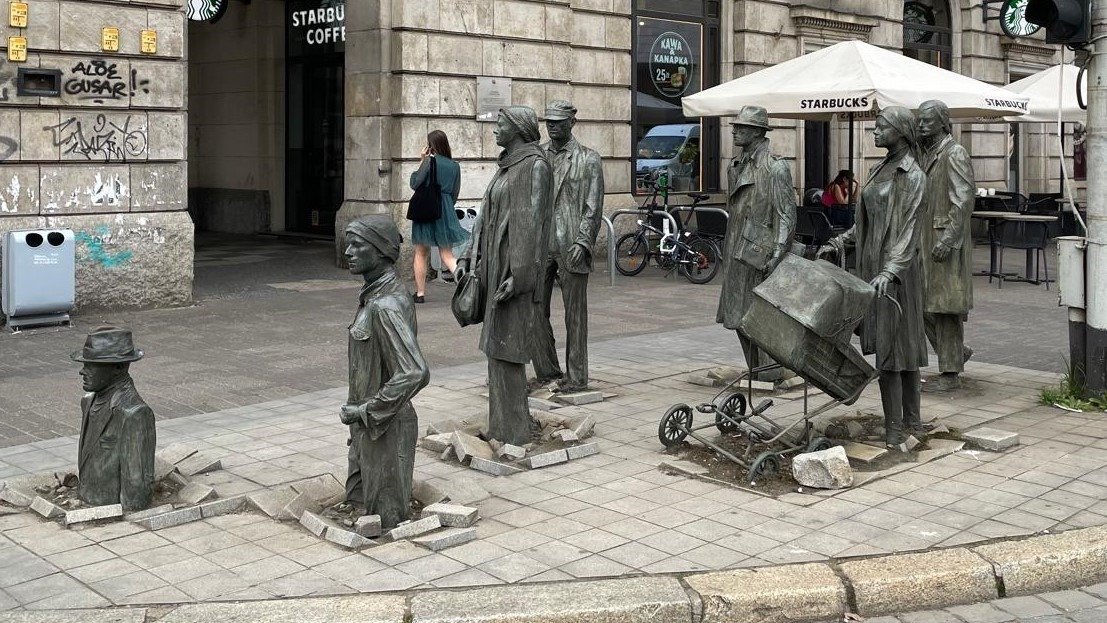
Are you planning to visit Berlin? Don’t you know exactly what to see in Berlin? Of course you do, the reasons are many: Berlin is the cradle of 20th century history; intense, artistic, eclectic and exciting today and a vision that is projected into the future as a green and ecological city. That is why we have written this little guide of what to see in Berlin through 10 unmissable places in the German capital.

Every tour of the city begins with the famous Brandenburg Gate, it is probably the most representative site of this city and of Germany, since it has been a traditional symbol of the division of the wall in the city of Berlin and also of the War period. cold; although currently celebrations, protests and state ceremonies are constantly held at this point which is located at the end of the main Berlin street, the traditional Unter den Linden Avenue (Under Los Tilos or Cherry Trees) and also welcomes the famous Tiergarten Park, to the other side of the door.
Why did you not know that it is not the only Brandenburg Gate? In 1770 King Frederick II “The Great” as another architectural test of Prussian power after finishing and obtaining victory in the Seven Years’ War (between 1756-1763), commissioned the construction of the Brandenburg Gate in the city of Potsdam to show that even after three wars Prussia’s economy was intact. At the same time, he commissioned the construction of the Brandenburg Gate in Berlin, which only began to be built in 1789. Two gates with the same name? Yes, because both are on the royal road to the city of Brandenburg, and you will notice that the oldest is in Potsdam, more of this you can discover in our post about the Gardens and Palaces of Sanssouci.
A few meters from this point you can visit the Reichstag, the German parliament building (Bundestag) built during the first days of the German Empire (1871). In those days the Prussian dynasty had reformed its model of government and following the example of other monarchies in Europe it had become a constitutional monarchy, in which there is a monarch and a head of state at the head. Have you heard of Otto von Bismarck? He was the first representative elected by the Bundestag (the 400-member parliament at that time) as prime minister-president (head of state), but unfortunately, he did not occupy this site, since its construction was only commissioned in 1884 by King Wilhelm II (last German emperor), who is said to have disapproved of the construction of the dome that crowned the building.
This place also became a symbol of the Weimar Republic, since the Hohenzollern monarchy was officially proclaimed and ended on the balcony of the building. Do you want to know more details about the history of this place? Do you want to know how to visit it? You can discover more about his visit in the free museums in Berlin post that we have made for you.

Speaking of the Bundestag, after long debates in 1999 it was decided to build a monument in a central place in the city to commemorate the victims of the Holocaust in Europe during the Nazi regime, the chosen point was a few meters from the Brandenburg Gate and the Reichstag. The winning project was the one presented by the New York architect (son of Polish immigrants) Peter Eisenman to develop 2,711 concrete columns of different heights in more than 19,000 square meters and to be able to walk on an undulating surface that makes the monument be perceived differently depending on the of the location of each visitor.
What is the design idea? The architect has not explained it and has left the visitor to have a unique and intimate experience to interpret what he is seeing. The entire monument and the documentation centre located in the basement can be visited for free. Do you want to know a little more about the history of the Jewish community in Berlin? visit the Jewish Museum of Berlin located in the Mitte-Kreuzberg district. You can discover more about your visit in the free museums in Berlin post that we have made for you.
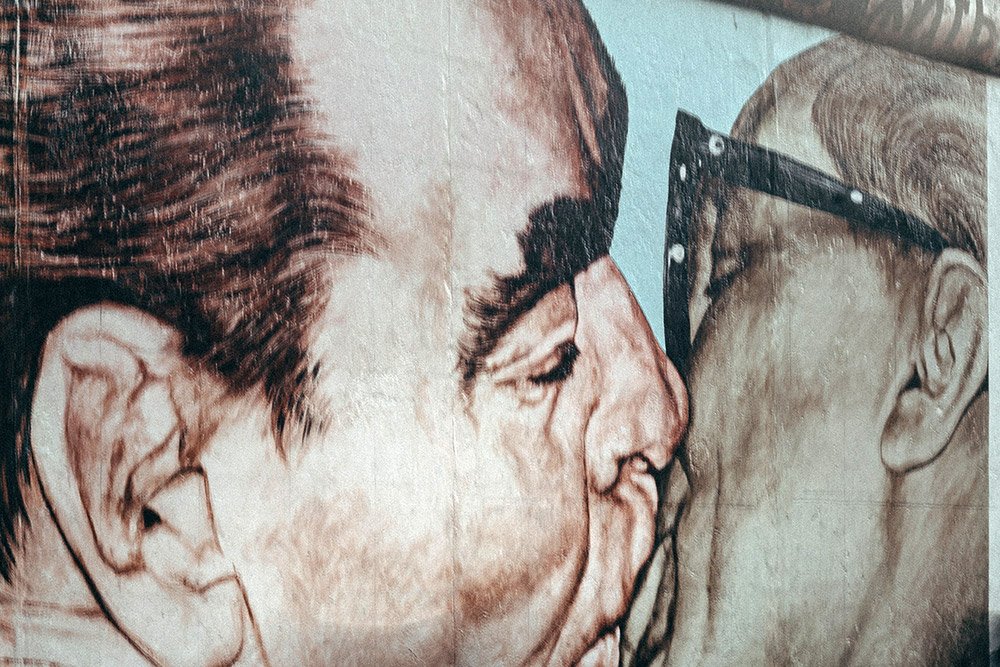
On August 13, 1961, the Berlin Wall was built in just one night, a wall located on the border of the Soviet zone (German Democratic Republic: GDR) from the American zone (German Federal Republic: FRG) of Berlin and dividing the city until its fall in 1989. Why was this wall built? In 1945, after the victory of the Allied bloc in World War II, it was decided to divide Germany and Berlin in particular between them, but over time the Soviet government noticed the massive flight of residents from the Soviet zone to the American zone, which they saw in that time better opportunities in the neighbouring country and, to avoid it, this construction was decided.
Today you can visit the East Side Gallery, a 1.3-kilometre piece of the wall that is still standing and in which artists moved by the feeling of hope after the fall of the wall gathered to leave their paintings. Surely you are wondering if this is the site of the famous “Brother’s Kiss” painting? Yes, this is a must-see spot in the city, where the famous royal moment shared by the socialist leaders Brezhnev and Honecker and painted by the muralist Dmitri Vrúbel is portrayed. It is of course one of the most recognized sites in the city and the largest open-air art gallery in the world. You can discover more about your visit in the free museums in Berlin post that we have made for you.
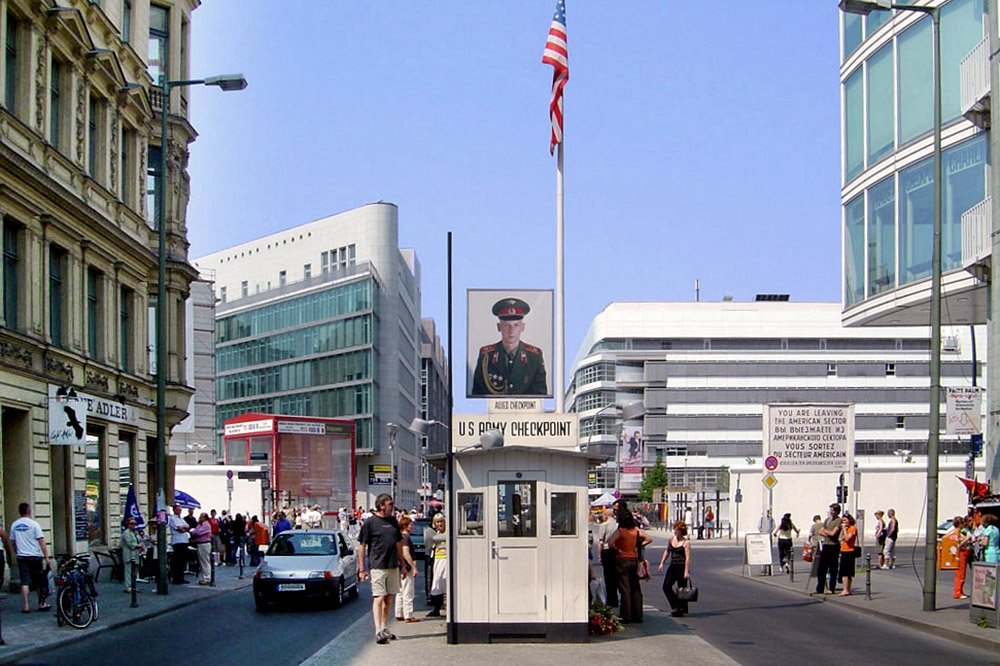
In the middle of Mitte (or Center) of the city, we find the famous Checkpoint Charlie border point that separated the Soviet zone from the American one: it was the third checkpoint (that’s why Charlie: Alpha, Beta, Charlie… in the radio alphabet of English language). English) established by the allied bloc for immigration control at the time. This site witnessed spectacular leaks, but the most critical moment was on October 27, 1961, in the so-called “Berlin Tank Crisis”. A confrontation in the midst of the Cold War between the Soviet and American blocs, in which, paradoxically, the powers made reciprocal demands for a ceasefire and demilitarization in the “Free City”.
Today it is a super famous place, where you can take pictures and you can also visit the documentation centre.
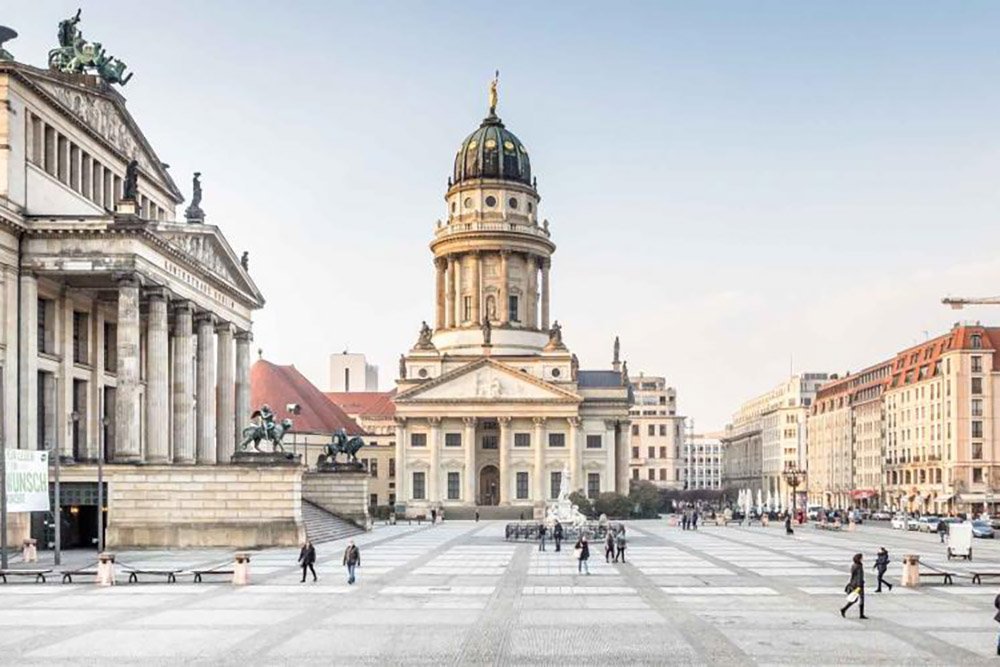
King Frederick, I (the first king of Prussia) at the end of the 17th century issued the famous “Edict of Potsdam” (you can discover more about this in our post about the Gardens and Palaces of Sanssouci), by which he commits himself to welcome the French exiled by King Louis XIV of France for religious reasons, which allowed the Huguenots who arrived in the newly formed Prussian kingdom to build a church at this point. However, the resident Lutheran community also demanded the construction of a church, so the king also allowed a church to be built here. The surprise? Surely you know these two churches that with the subsequent reform of King Frederick II “The Great” when they began to be called the “sister cathedrals” (because of their domes). Very central in the square we find the Konzerthaus building and a statue of the poet Friedrich Schiller.
Walking just a few steps towards Unter den Linden we find the Bebelplatz, where some of the most famous buildings in the city are built, such as the State Opera, the Hedwig Cathedral, the Hotel Roma, the Old Library (today the Faculty of Law of the Humboldt University) and Humboldt University itself. You may be wondering: what role did this point play during the Nazi era? Currently, we find here a memorial that commemorates the burning of books on May 10, 1933, carried out by the Nazis as a way of silencing writers who have fallen into disgrace by the regime.

This is one of the main tourist attractions in Berlin, the so-called Museum Island is really an island in the Spree river where 5 of the most famous museums in Germany are located: The Altes Museum, the Neues Museum, the Gallery Nacional, the Pergamon Museum and the Bode Museum, and since 1999 it has held the title of UNESCO World Heritage.
Not many introductions are needed for this site, here you can find traces of classical Roman and Greek, Egyptian and Mesopotamian history. The two favourites: Do you want to see Nefertiti and the Pergamon Altar? in the Neues Museum you can visit the bust of her and, in the Pergamon, we can find the famous altar brought from the ancient city of Pergamon (although today it is under restoration and instead you can visit the 360 ° Panorama exhibition of the city of Pergamon).
On the other side of the Museum Island, you can visit the recently inaugurated and open Humboldt Forum, a historical reconstruction of the old baroque royal palace of the Hohenzollern (17th century) that harmonizes its construction with the Palace of the Republic built by the Democratic Republic German (the GDR in the 1970s). Today it houses the Global Berlin and Humboldt Laboratory exhibitions, as well as the Ethnological Museum and the Asian Art Museum. You can discover more about her visit in the free museums in Berlin post that we have made for you.

Continuing with this list of what to see in Berlin, we find Alexanderplatz. This site, named after the Russian Tsar Alexander I, who visited the city in 1805, is a place that needs no introduction: a meeting place, a tourist site par excellence, a hub for public transportation, the site of the largest warehouses in the city, this point is recognized as “Alex” by the Berliners themselves. Is it a surprise for you to know that the famous Weltzeituhr World Clock and the most famous Television Tower (Fernsehturm) are located in this place? Probably not, but what will be a surprise for you is to visit the square, because it is a place highly historical and representative of current Berlin culture.

The Jewish quarter located in Hackescher Markt is one of the most visited neighbourhoods in Berlin today, it is a bohemian neighbourhood and tells the story of the Jewish community present in the city historically. Many of the great restaurants, cafes and bars are located at this point, but it is also a place that combines the best of Berlin’s Street Art and where we also find the Anna Frank Documentation Center and the oldest Jewish Cemetery in Berlin. So how does this point combine bohemian life and the memory of the Jewish community? It really is wrong to speak of a Jewish neighbourhood in Berlin, since the community spread throughout the city and here the most important thing was only the cemetery and the synagogue, but it was not the only place where Berlin Jews lived and, in fact, , next we will talk about another important site.
Another of the places where the Jewish community historically spread out is in the Ku’damm, today a famous avenue converted from the time of the Federal Republic of Germany (FRG in the mid-1950s) into the site of the department stores in Berlin of the West. Here we find the KaDeWe shopping centre that houses the most prestigious luxury brands in the world in a single building, the Bikini shopping centre (yes, just like it sounds! and remembering summer) and the Europa-Center. Also in the vicinity, we can find the City Zoo and the Berlin Aquarium.
Finally, a highlight of this visit is the Kaiser Wilhelm I Memorial Church, built in honour of the first German Emperor. The bell tower is the second largest in Germany (only after Cologne) and its current state of destruction represents a form of remembrance, memory and reconciliation of the bombing experienced in the city in May 1945, when the Second World War ended. World Cup and currently commemorates the willingness of Berliners to collect themselves in the post-war period, making it a very good point to end our tour in Berlin.
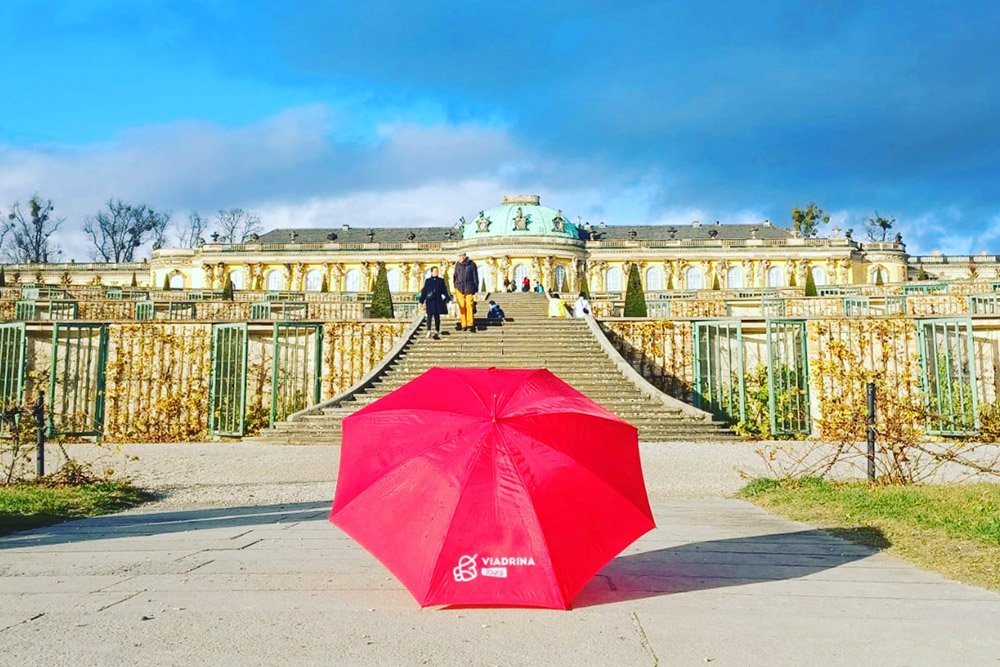
On the outskirts of Berlin, you must visit the city of Potsdam, you will be attracted by its famous palaces and castles and in particular the famous Sanssouci Palace, however here comes the surprise: Potsdam is much more than this place, it has about 30 palaces and, in fact, the Sanssouci Palace is located in the Sanssouci Park, which houses 3 more large palaces and a series of small palaces and historical monuments. This place represents a symbol in Berlin-Brandenburg since it is one of the two World Heritage sites declared by Unesco in this city (the other is the Russian village of Alexandrowka and if you were wondering if it is related to Alexanderplatz: the answer is yes and you can discover it in our post about the Gardens and Palaces of Sanssouci)).
As you can see Berlin is a city full of history, it is not only the birthplace of the Nazi regime and the Cold War but also a city with a long history that vibrates towards the future. If you want to have a unique experience and discover everything, tips to visit Berlin, do not hesitate to take one of our Free Walking Tours with us, we are waiting for you!

This is the second part of our article 20 fun facts about Germany (Part One).
In this article we tell you some of the most interesting facts about Christmas in Germany. Ready?
In this post we tell you about the best German music, different rhythms and it comes with a playlist included!